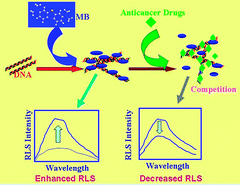A new way to detect the interaction of DNA and anticancer drugs based on the decreased resonance light scattering signal and its potential application†
Abstract
A novel assay has been developed to detect the interaction of

* Corresponding authors
a
Department of Chemistry, Shantou University, Shantou, China
E-mail:
kqlu@stu.edu.cn
Fax: +86 075482902767
Tel: +86 075482903330
b Guangdong Pharmaceutical University, Guangzhou, China
c Medical College of Shantou University, Shantou, China
A novel assay has been developed to detect the interaction of

 Please wait while we load your content...
Something went wrong. Try again?
Please wait while we load your content...
Something went wrong. Try again?
Z. Chen, T. Song, Y. Peng, X. Chen, J. Chen, G. Zhang and S. Qian, Analyst, 2011, 136, 3927 DOI: 10.1039/C1AN15507E
To request permission to reproduce material from this article, please go to the Copyright Clearance Center request page.
If you are an author contributing to an RSC publication, you do not need to request permission provided correct acknowledgement is given.
If you are the author of this article, you do not need to request permission to reproduce figures and diagrams provided correct acknowledgement is given. If you want to reproduce the whole article in a third-party publication (excluding your thesis/dissertation for which permission is not required) please go to the Copyright Clearance Center request page.
Read more about how to correctly acknowledge RSC content.
 Fetching data from CrossRef.
Fetching data from CrossRef.
This may take some time to load.
Loading related content
